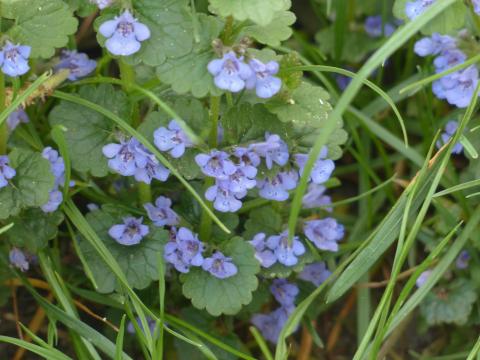Controlling Ground Ivy

Ground ivy (Glechoma hederaceae), also known as creeping Charlie, is a perennial weed that can be very difficult to get rid of. Not only does the root system of this weed survive from season to season, but it can also produce vast amounts of seed that have the potential to remain viable in the soil for years. To complicate matters further, ground ivy can adapt to many different growing conditions, although it is most often a problem in damp, shady, infertile lawns. Under such circumstances, it will rapidly outcompete shade-intolerant turf grass species and be a source of frustration to any gardener wishing to maintain a healthy, weed-free lawn. Fortunately, with correct identification and a little persistence, it is quite possible to eliminate it from your yard.
Ground ivy is easy to distinguish from other common broadleaf weeds. A member of the mint family, ground ivy grows close to the ground and produces square, creeping stems and leaves with distinctive scalloped edges. It also releases a slightly aromatic scent when the stems and foliage are cut or crushed, such as immediately after mowing. The violet-blue, tubular flowers appear in spring and grow along the stems.
As in dealing with many other turfgrass problems, the first thing you should do is evaluate your site conditions. The conditions that favor the growth of ground ivy are quite the opposite of those that are best for turf. Improving drainage, increasing fertility, allowing additional light to reach the lawn, and raising the mower height to three inches will go a long way toward giving turf grass a competitive advantage. Consider getting your soil tested to determine the fertilizer needs of your lawn, and when reseeding, choose a turf grass mix that is shade tolerant.
If you have improved your site conditions and ground ivy is still an issue, the next step is to eliminate the weed itself. Hand-pulling is an option for those with endless time and patience, but be careful to remove all of the many roots along the stem. If hand-removal sounds too tedious, some broadleaf herbicides can be effective if they are applied at the right time. The most effective time to apply herbicides is during bloom in the spring and in the late fall. Ask UNH Extension for specific recommendations and always read and follow the label before applying any pesticide product.
Got questions? The Ask UNH Extension Infoline offers practical help finding answers for your home, yard, and garden questions. Call toll free at 1-877-398-4769, Monday to Friday, 9 a.m. to 2 p.m., or e-mail us at answers@unh.edu.
